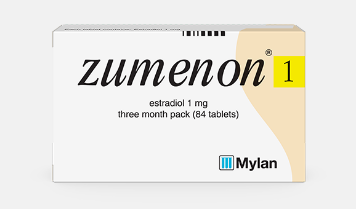Night sweats
Night sweats are vasomotor symptoms commonly observed in women during menopause, which can be described as profuse sweating at night, causing sleep disturbance. Night sweats occur due to a reduction in estradiol concentration in serum and hypothalamic temperature-regulating centre.1
Night sweats are episodes of severe sweating during the night, which can leave an individual drenched in sweat and may lead to disturbed sleep, which can in turn lead to mood disorders and reduction in the quality of life.1 Night sweats and hot flushes are vasomotor symptoms that occur during menopause.1
What do we have in common?
We all go our own way.
Are night sweats common in menopause?
Night sweats frequently occur in perimenopausal and postmenopausal women. Night sweats occur along with hot flushes, which results in profuse perspiration during sleep, leading to sleep disturbances.2,3 Night sweats gradually reduce in frequency and severity in postmenopausal women. However, in some women, they may last throughout the rest of their lifetime.3
What causes night sweats during menopause?
Vasomotor symptoms (VMS) such as hot flushes and night sweats are frequently encountered during the menopausal transition. These symptoms are related to decreasing estradiol concentrations, which affect the temperature regulating centre. Estrogen deficiency alters the serotonergic and noradrenergic pathways, involved in temperature control.1
Treating hot flushes and night sweats
Vasomotor symptoms of hot flushes and night sweats can be managed with pharmacological and non-pharmacological modalities. Adapt the treatment to the individual needs of the woman:
Non-pharmacological treatments:
Cognitive behavioral therapy, mindfulness training, acupuncture and hypnosis may be useful, although definitive evidence is lacking.4
Complementary therapies such as isoflavones or black cohosh may relieve vasomotor symptoms, however their evidence is controversial and safety is uncertain.4,5
Pharmacological treatments:
Hormone replacement therapy (HRT), can be offered to women for vasomotor symptoms after discussing with them the short-term (up to 5 years) and longer-term benefits and risks. Offer a choice of preparations as follows:5
- Estrogen and progestogen to women with a uterus
- Estrogen alone to women without a uterus
Do not routinely offer selective serotonin reuptake inhibitors (SSRIs), serotonin and norepinephrine reuptake inhibitors (SNRIs) or clonidine as first-line treatment for vasomotor symptoms alone.5
What are the available preparations of HRT?
HRT includes a wide range of products with varied hormonal components, route of administration and dosage, which are all associated with different benefit and risk profiles.6
The estrogen which is most commonly prescribed is micronised 17β-estradiol. This is available in the form of patches, sprays, gels or tablets. 17β estradiol is a regulated bioidentical (rBHRT) or "body identical" hormone, with similar effects to the body's naturally produced estrogen.7
Progestogens are indicated to protect the endometrium from hyperplasia and carcinoma, and the dose, duration and type of progestogen is important when considering which HRT treatment to offer. Progestogens commonly used can include dydrogesterone and micronised progesterone. When adequate progestogen or dydrogesterone is combined with estrogen, the risk of endometrial hyperplasia and cancer is reduced to that of baseline women (women not taking HRT).6,8,9
-
References
- 1) Rossmanith WG, Ruebberdt W. What causes hot flushes? The neuroendocrine origin of vasomotor symptoms in the menopause. Gynecol Endocrinol. 2009 Jan;25(5):303-14.
- 2) Stearns V, Ullmer L, Lo′pez JF, Smith Y, Isaacs C, Hayes DF. Hot flashes. Lancet. 2002 Dec 7;360:1851-61.
- 3) Deecher DC, Dorries K. Understanding the pathophysiology of vasomotor symptoms (hot flashes and night sweats) that occur in perimenopause, menopause, and postmenopause life stages. Arch Womens Ment Health. 2007 Dec;10:247-57.
- 4) Baber RJ, Panay N, Fenton AT. 2016 IMS Recommendations on women’s midlife health and menopause hormone therapy. Climacteric.16 Mar;19(2):109-50.
- 5) NICE. Menopause: diagnosis and management. NG23. Available at: www.nice.org.uk/guidance/ng23 (accessed September 2021).
- 6) The NAMS 2017 Hormone Therapy Position Statement Advisory Panel. The 2017 hormone therapy position statement of The North American Menopause Society. Menopause (New York, NY). 2017 Jul;24(7):728-753.
- 7) Hamoda H et al. The British Menopause Society & Women’s Health Concern 2020 recommendations on hormone replacement therapy in menopausal women. Post Reproductive Health. October 2020.
- 8) Femoston® 1/10mg. Summary of Product Characteristics.
- 9) Femoston® 2/10mg. Summary of Product Characteristics

Zumenon®
Zumenon® is indicated for estrogen deficiency symptoms in postmenopausal women at least 6 months since last menses.

HRT TREATMENT NAVIGATOR
An interactive tool to help tailor individual therapy using the Viatris broad portfolio of HRT treatment options. Answer 2-6 simple questions to get an option now.
HCP Disclaimer
This website is intended for UK healthcare professionals only.
Viatris Connect is an online platform for UK healthcare professionals.
Across the website you will find news, blogs and product information.
FREE Menopause and HRT webinars available to watch by registering to Viatris Connect today
Please note that the website contains promotional and non-promotional material including educational content and resources to help you and your patients.
REGISTER NOW




